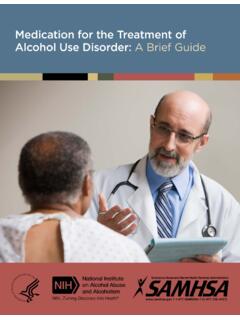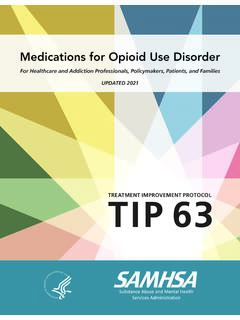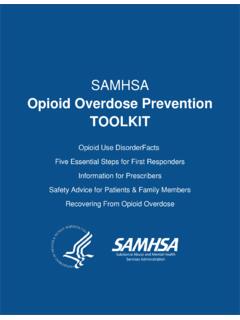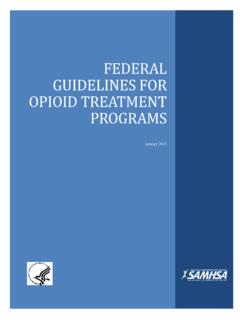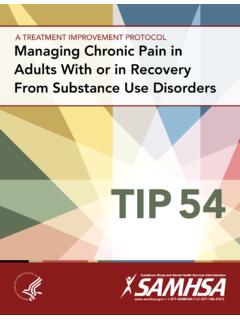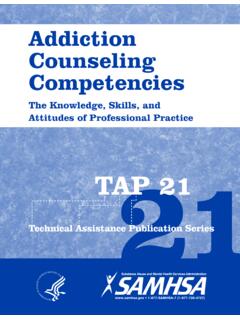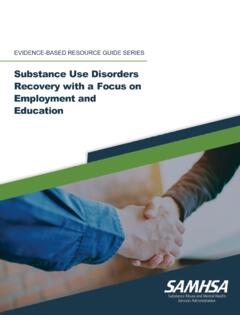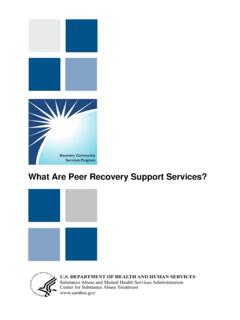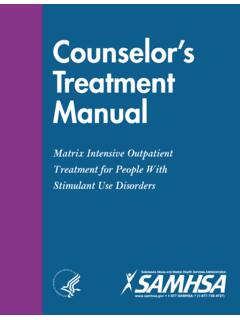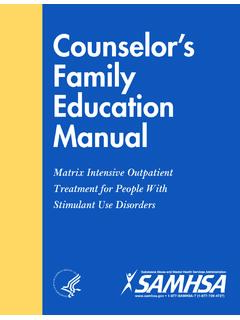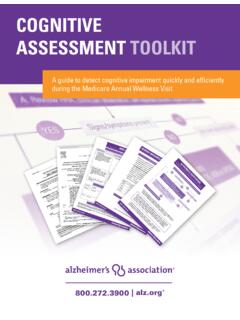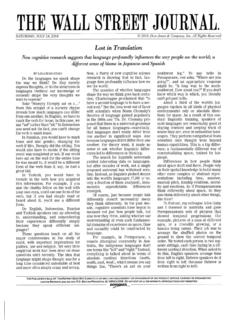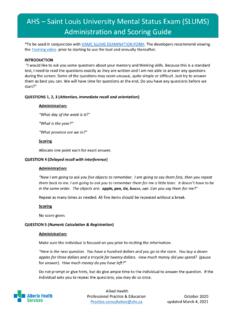Transcription of Screening and Assessment of Co-occuring Disorders in the ...
1 Screening and Assessment of Co- occurring Disorders in the Justice System Screening and Assessment of Co- occurring Disorders in the Justice Department of Health and Human ServicesSubstance Abuse and Mental Health Services AdministrationAcknowledgmentsThis report was prepared for the Substance Abuse and Mental Health Services Administration (SAMHSA) by Policy Research Associates, Inc. under SAMHSA IDIQ Prime Contract #HHSS283200700036I, Task Order #HHSS28342003T with SAMHSA, Department of Health and Human Services (HHS). The original report was authored by Roger H. Peters, PhD, Elizabeth Rojas, MA, and Marla G. Bartoi, PhD of the Louis de la Parte Florida Mental Health Institute, University of South Florida. David Morrissette, PhD, served as the Contracting Officer views, opinions, and content of this publication are those of the author and do not necessarily reflect the views, opinions, or policies of SAMHSA or HHS.
2 Nothing in this document constitutes a direct or indirect endorsement by SAMHSA or HHS of any non-federal entity s products, services, or policies, and any reference to non-federal entities products, services, or policies should not be construed as Domain NoticeAll material appearing in this report is in the public domain and may be reproduced or copied without permission from SAMHSA. Citation of the source is appreciated. However, this publication may not be reproduced or distributed for a fee without the specific, written authorization of the Office of Communications, SAMHSA, Access and Copies of PublicationThis publication may be downloaded at Or, call SAMHSA at 1-877-SAMHSA-7 (1-877-726-4727) (English and Espa ol).Recommended CitationSubstance Abuse and Mental Health Services Administration. Screening and Assessment of Co- occurring Disorders in the Justice System.
3 HHS Publication No. PEP19-SCREEN-CODJS. Rockville, MD: Substance Abuse and Mental Health Services Administration, OfficeOffice of Behavioral Health Equity and Justice Informed, Substance Abuse and Mental Health Services Administration, 5600 Fishers Lane, Rockville, MD 20852. HHS Publication No. PEP19-SCREEN-CODJSN ondiscrimination NoticeSAMHSA complies with applicable federal civil rights laws and does not discriminate on the basis of race, color, national origin, age, disability, or sex. SAMHSA cumple con las leyes federales de derechos civiles aplicables y no discrimina por motivos de raza, color, nacionalidad, edad, discapacidad, o printed in 2015 Revised June 2019 ContentsExecutive Summary ..1 Key Issues in Screening and Assessment of Co- occurring Disorders in the Justice System ..5 Prevalence and Significance of Co- occurring Disorders in the Justice System.
4 5 Defining Co- occurring Disorders ..7 Changes to the DSM-5 Diagnostic Classification System 8 Distinguishing between Co- occurring Disorders : Differential Diagnoses 10 Importance of Screening and Assessment for Co- occurring Disorders in Justice Settings .11 Opportunities for Screening and Assessment ..13 Intercept 0: Community Services 13 Intercept 1: Law Enforcement 14 Intercept 2: Initial Detention/Initial Court Hearings 15 Intercept 3: Jails/Courts 16 Intercept 4: Reentry 17 Intercept 5: Community Corrections 17 Defining Screening and Assessment ..18 Screening19 Assessment20 Developing a Comprehensive Screening and Assessment Approach ..24 Key Information To Address in Screening and Assessment for Co- occurring Disorders ..26 Risk Factors for Co- occurring Disorders 26 Observable Signs and Symptoms of Co- occurring Disorders 27 Indicators of Mental Disorders 27 Indicators of Substance Use Disorders 27 cognitive and Behavioral Impairment 27 Other Psychosocial Areas of Interest 29 Criminal Justice Information 29 Drug Testing 30 Enhancing the Accuracy of Information in Screening and Assessment .
5 36 Symptom Interaction between Co- occurring Disorders 36 Accuracy of Self-report Information 37 Use of Collateral Information 38iiiUse of an Extended Assessment Period 39 Other Strategies To Enhance the Accuracy of Screening and Assessment Information 40 Special Clinical Issues in Screening and Assessment for Co- occurring Disorders in the Justice System ..41 Risk Assessment 41 Evaluating Suicide Risk 44 Trauma History and Posttraumatic Stress Disorder (PTSD) 47 Motivation and Readiness for Treatment 49 Cultural Issues Related to Screening and Assessment 52 Staff Training 54 Instruments for Screening and Assessing Co- occurring Disorders ..57 Key Issues in Selecting Screening and Assessment Instruments ..57 Comparing Screening Instruments ..58 Recommended Screening Instruments ..58 Issues in Conducting Assessment and Diagnosis 61 Recommended Instruments for Assessment and Diagnosis of Co- occurring Disorders .
6 62 Screening Instruments for Substance Use Disorders ..63 Changes to the DSM-5 Diagnostic Classification System 64 Screening Instruments 64 Recommendations for Substance Use Screening Instruments 86 Screening Instruments for Mental Instruments for Depression 87 General Screening Instruments for Mental Disorders 91 Recommendations for Mental Health Screening Instruments 100 Screening Instruments for Co- occurring Mental and Substance Use Disorders ..100 Recommendations for CODs Screening Instruments 108 Screening and Assessment Instruments for Suicide Risk ..109 Suicide Risk Screening Instruments 110 Suicide Risk Assessment Instruments 114 Recommendations for Suicide Risk Screening Instruments 114 Screening and Diagnostic Instruments for Trauma and PTSD ..115 Changes to the DSM-5 Diagnostic Criteria for PTSD 116 Screening Instruments for Trauma/PTSD 116 Screening Instruments for Traumatic Life Events and Associated Symptoms 124 Diagnostic Instruments for PTSD 130 Recommendations for Trauma/PTSD Screening , Assessment , and Diagnostic Instruments 134 Screening Instruments for Motivation and Readiness for Treatment.
7 135ivScreening and Assessment of Co- occurring Disorders in the Justice SystemFigures and TablesFigure 1. The Sequential Intercept Model ..13 Figure 2. Intercept 0: Community Services ..14 Figure 3. Intercept 1: Law Enforcement ..14 Figure 4. Intercept 2: Initial Detention/Initial Court Hearings ..15 Figure 5. Intercept 3: Jails/Courts ..16 Figure 6. Intercept 4: Reentry ..17 Figure 7. Intercept 5: Community Corrections ..18 Table 1. Comparison of Alternate Drug Testing Methodologies ..34 Figure 8. Recommended Screening Instruments ..59 Figure 9. Recommended Assessment Instruments ..63 Screening Instruments for Motivation and Readiness for Treatment 135 Recommendations for Motivational Screening Instruments 146 Assessment Instruments for Substance Use and Treatment Matching Approaches ..146 Identifying Gaps in Offender Services 147 Treatment Matching Approaches 147 Substance Use Assessment Instruments and Treatment Matching 153 Recommendations for Assessment of Substance Use and Treatment Matching 163 Assessment Instruments for Mental Disorders .
8 163 Recommendations for Assessment of Mental Disorders 172 Assessment and Diagnostic Instruments for Co- occurring Mental and Substance Use Disorders ..172 Assessment Instruments for Co- occurring Mental and Substance Use Disorders 172 Diagnostic Instruments for Co- occurring Mental Health and Substance Use Disorders 178 Recommendations for Assessment and Diagnosis of CODs 188 Suggested ..191 Contributors ..257vContentsThis monograph examines a wide range of evidence-based practices for Screening and Assessment of people in the justice system who have co- occurring mental and substance use Disorders (CODs). Use of evidence-based approaches for Screening and Assessment is likely to result in more accurate matching of offenders to treatment services and more effective treatment and supervision outcomes (Shaffer, 2011). This monograph is intended as a guide for clinicians, case managers, program and systems administrators, community supervision staff, jail and prison booking and healthcare staff, law enforcement, court personnel, researchers, and others who are interested in developing and operating effective programs for justice-involved individuals who have CODs.
9 Key systemic and clinical challenges are discussed, as well as state-of-the art approaches for conducting Screening and Assessment . The monograph also reviews a range of selected instruments for Screening , Assessment , and diagnosis of CODs in justice settings and provides a critical analysis of advantages, concerns, and practical implementation issues ( , cost, availability, training needs) for each instrument. A number of the evidence-based instruments described in this monograph are available in the public domain ( , are free of charge) and can be downloaded on the internet. Not all of the instruments described in this monograph are designed for universal use in Screening or assessing for both mental and substance use Disorders , and some may not be suitable for use with special populations or in specific justice settings. For example, the Screening and Assessment instruments described here are primarily designed for use with adults in the justice system, and many have not been validated for use with juveniles.
10 Many of the Assessment instruments reviewed in this monograph also require specialized training and clinical expertise to administer, score, and interpret. These considerations are explored in more detail in later sections of this monograph that review specific instruments. A significant and growing number of people in the justice system have CODs. For example, over 70 percent of offenders have substance use Disorders , and approximately 17 34 percent have serious mental illnesses rates that greatly exceed those found in the general population (Baillargeon et al., 2010; Ditton, 1999; Lurigio, 2011; SAMHSA s GAINS Center, 2004; Peters, Kremling, Bekman, & Caudy, 2012; Steadman, Osher, Robbins, Case, & Samuels, 2009; Steadman et al., 2013). Several populations, such as juveniles, female offenders, and veterans, are entering the justice system in increased numbers and have elevated rates of CODs, including substance use, trauma, and other mental Disorders (Houser, Belenko, & Brennan, 2012; Pinals et al.)
